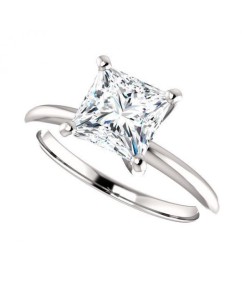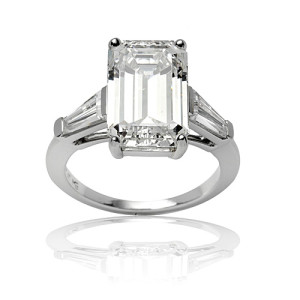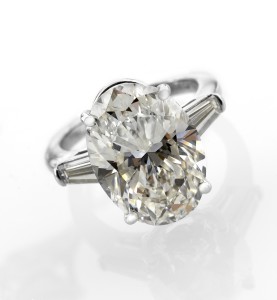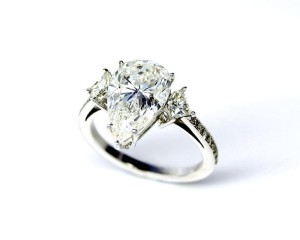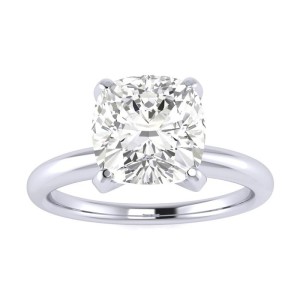A Word on Diamond Shapes
Diamonds come in numerous shapes. There is no right or wrong choice, it is all about personal preference. For a manufacturer, the final shape is dictated by the form of the rough and the placement of the inclusions in the stone. Here is a description of the major shapes and their characteristics.
Round brilliant
The round brilliant shape is by far the most popular one and for very good reasons. First, from the manufacture’s perspective, it is the shape that sells for the highest price and that maximizes the yield of the rough. In fact, it is estimated that a brilliant of comparable size and quality will sell between 25% and 30% higher versus the other shapes. Also, the round brilliant enables the retention of 60% to 80% of the original weight of the rough diamond versus 40% à 50% for some other shapes.
It is the shape that gives out the most fire and scintillation
From the consumers vantage point, the symmetry of the facets and proportion of the forms, allows for the maximum reflection and dispersion of the light. For this reason, it is the shape that gives out the most fire and scintillation. The « modern » round brilliant is the version that was developed and perfected by Marcel Tolkowshy in 1919 and which has 58 facets. Finally, when comparing a round diamond with a square one of similar weight, the round always appears larger. This optical advantage is another undeniable benefit that contributes to its commercial success.
Princess
After the round, it is the Princess cut that is the most widespread. It is a square or slightly rectangular shape which generally has 76 facets. This is a great form for modern looking jewelry with well-defined straight lines. Since the table (the facet on the of the stone) is large, the inclusions are easier to spot. It is therefore preferable to choose a stone with a higher clarity grade.
Emerald
This cut was usually reserved for cutting the emerald stone, thus the origin of the name. It is a sober, very classical looking form reminiscent of the roaring twenties with typical art deco lines. It was often the preferred shape of Louis Cartier or Harry Winston for larger diamonds.
« When you look at the stone from the top, you see the appearance of parallel escalators going down deep into the stone. This triggers the desire to stare into the beauty of the diamond. » says Louis-Alexandre Laferrière.
In fact, it is the contour of an emerald diamond that inspired the logo of Laferrière & Brixi Diamantaires Inc.
Oval
The oval shape shares many of the characteristics of the round brilliant but with a clear elongated central axis. One of its particularity, is that it exhibits a black reflection in the center of the stone which resembles that of a « bow tie ». For the stone to be desirable, the « bow tie » effect needs to be apparent but not overwhelming. The right visual balance will bear a significant impact on the price of the stone. The diamond experts at Laferrière & Brixi can help advise you to find the perfect oval shape diamond for you.
Pear
Diamond shapes follow trends and the pear shape his certainly the most popular one at this moment. As per the oval, the pear shape also produces a « bow tie » effect. It is therefore important that you be able to inspect the stone prior to its purchase and confirm its value. The pear shape is very dramatic and looks impressive for its weight. It is an ideal shape for a pendant or drop earrings.
Cushion
The cushion shape is also very much sought after. It is important to distinguish between the « cushion brilliant » and the other regular cushions. The « cushion brilliant » is a shape which is recognized by the GIA (Gemological Institute of America). This cut shares similarities to the round brilliant but with a squarish contour.
Radiant
The radiant shape borrows numerous structural elements of the other diamond shapes. It is generally rectangular looking, with straight cut corners, a larger table on top and numerous facets on the bottom. The asymmetric arrangement of the facets gives it the appearance of broken or crushed ice. It is namely because of this asymmetry, that the radiant is often the shape of choice for cutting colored diamonds. More specifically, the asymmetry of the facets increases the color saturation in the stone.
New diamond shapes
Research and development for new diamond shapes is a never-ending endeavor. However, the main objective, is mostly concentrated on improving on the classic round brilliant shape to maximize light performance and increase scintillation. Numerous patents have been registered to that effect for round shapes that usually have a very high number of facets versus 58 on the original version.
Unfortunately, notwithstanding the claim of « increased performance », there exists many inconveniences to purchase new shape diamonds. First, because you are dealing with a patent, no manufacturer other than the patent holder can cut these shapes without prior authorization. This significantly reduces the distribution of these products to niche segments. Consequently, there is very little appetite for these diamonds on the secondary market and their value significantly lowered.
Established for over 20 years, Laferrière & Brixi Diamantaires Inc. is a leading buyer and seller of important diamonds and custom-made jewelry. For an appointment at one of our offices please call 844-671-3101 or send us an e-mail at info@lbdiamantaires.com
Montreal | New York


